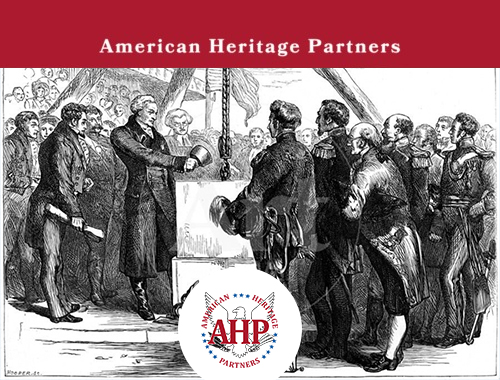This month we commemorate one of the most heartfelt moments in American history, when Americans everywhere turned out to welcome the return to the United States of the Marquis de Lafayette, who had been invited by President James Monroe to come to the United States as “The Nation’s Guest” to help celebrate the 50th anniversary of the beginning of the Revolutionary War in April 1775. A young French aristocrat born into a wealthy family with strong ties to the French monarchy, Lafayette nevertheless was a vocal supporter of the American move for independence, and at age 17 he sailed to America to join the rebel cause. In part because of his close ties to the French royal court, Lafayette was commissioned a general in the Continental Army (perhaps to the dismay of a number of American officers). Lafayette quickly became one of George Washington’s most trusted aides during the war. Indeed, so close was that relationship that many historians and contemporary observers have likened the relationship of Washington and Lafayette to one of father and son.

Today, Lafayette is credited as having been a heroic military leader, who led his troops into battle, and who played a major role in America’s victory at Yorktown. More importantly, Lafayette served as a key intermediary between the American government and King Louis XVI of France, whom Lafayette well knew during his early life in Paris, and with whom Lafayette could be considered a close confidante. It was in no small part due to Lafayette’s friendship with the King and other members of the royal court that France ultimately decided to enter the War as an ally of the Americans, and to send its army and naval forces to America to aid the cause. Indeed, many historians contend that without France’s intervention, America would not have won the war.
Lafayette’s military exploits will not be repeated here, other than to say that for someone who had absolutely no military experience before coming to America, he quickly developed the skills needed to wage war, and that he acquitted himself well on the battlefield. After the war ended in 1783, Lafayette returned to France a hero, bringing with him the conviction that France, too, should turn towards a more democratic form of government. In 1789, as the French Revolution was just beginning, Lafayette found himself squarely in the middle of the revolutionary fervor— loyal to the King, but also an advocate for the rights of the common man. With behind-the-scenes help of Thomas Jefferson, he wrote and published the “Declaration of the Rights of Man and of the Citizen,” in which he argued that France should adopt reforms similar to America’s Bill of Rights. Yet, in the same year Lafayette was named Commander in Chief of the National Guard that was sent into the streets of Paris to quell the violence being committed by angry mobs; he was there at the storming of the Bastille, and his leadership helped to restore order— at least momentarily.
In due course the French Revolution turned ugly, leading to the infamous “Reign of Terror,” during which hundreds of loyalists to the King— and ultimately the King himself— were guillotined. Because Lafayette did not ascribe to the more radical elements of the revolutionary agenda, and perhaps was viewed as having loyalist sympathies, in 1792 he was imprisoned, and languished in various dank prison cells for the next five years, until he was liberated in 1797 by none other than Napoleon. Lafayette returned to private life at his chateau, La Grange, refusing Napoleon’s invitation to join his government in 1815. But his revolutionary days were not yet over: in 1827, he became a fierce critic of King Charles X, and joined the rebels who were manning the barricades of Paris in 1830, causing King Charles to abdicate. After Louis Philippe took the throne, Lafayette continued his criticisms of the monarchy until his death in May 1834 at the age of 77.
Lafayette’s Tour of America began when he landed in New York harbor on August 18, 1824. He was met by over 50,000 Americans who turned out to greet him— the largest crowd ever assembled in America to that point (only 5,000 greeted the Beatles!). Everywhere he went there were parades, flags, banners, banquets, buildings and bridges festooned with flowers, and all manner of speeches and testimonials. Over the next 13 months he traveled over 6,000 miles, visiting all 24 states in our then-young country, meeting with important political leaders along the way, as well as thousands of average citizens who lined the roads and waterways he traversed. Lafayette visited six American presidents, past present and future: Adams, Jefferson, Madison, Monroe, John Quincy Adams, and Andrew Jackson (John Quincy was elected president during Lafayette’s tour; John Quincy’s father John Adams and Thomas Jefferson both died while Lafayette was still in America). He also met with Native-American leaders, as well as anti-slavery advocates— Lafayette was a fierce opponent of slavery, and he spoke out on this subject on many occasions during the tour. Most touching were his reunions with former soldiers who fought in the Revolution, some of whom he remembered by name, and all of whom honored him for his central role in the cause of freedom, and his advocacy for the rights of man.
Lafayette’s Tour of America culminated on June 17, 1825, when Lafayette traveled to Boston to lay the cornerstone for the new monument being built to commemorate the Battle of Bunker Hill. Tens of thousands of citizens on that day to honor the memory of those who fought at Bunker Hill, but also to pay homage to Lafayette, who was then the last living Continental Army general. Demonstrating his enduring love of America, Lafayette had a trunk filled with dirt from Bunker Hill, which he took back to France, with instructions that when he died, the dirt was to be placed on top of his casket. And so it came to be.

